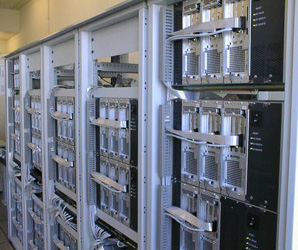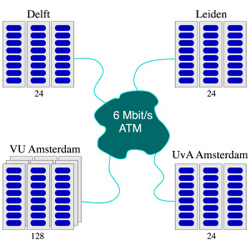
ERCIM News No.45 - April 2001 [contents]

![]()
ERCIM News No.45 - April 2001 [contents]
by Henri Bal
The Distributed ASCI Supercomputer (DAS) is an experimental testbed for research on wide-area distributed and parallel applications. The system was built for the Advanced School for Computing and Imaging (ASCI), a Dutch research school in which several universities participate.
The goal of DAS is to provide a common computational infrastructure for researchers within ASCI, who work on various aspects of parallel and distributed systems, including communication substrates, programming environments, and applications. Like a metacomputer or computational grid, DAS is a physically distributed system that appears to its users as a single, coherent system. Unlike metacomputers, we designed DAS as a homogeneous system.
The DAS system consists of four cluster computers, located at four different universities in ASCI, linked together through wide area networks. Three clusters (at the Universities of Amsterdam, Leiden and Delft) have 24 nodes; the cluster at the Vrije Universiteit has 128 nodes. All four clusters use the same processors (Pentium Pro) and local network (Myrinet) and run the same operating system (RedHat Linux). Each university has fast access to its own local cluster. In addition, a single application can use the entire wide-area system, for example for remote collaboration or distributed supercomputing. DAS can be seen as a prototype computational grid, but its homogeneous structure makes it easier to avoid the engineering problems of heterogeneous systems. DAS can also be seen as a cluster computer, except that it is physically distributed.
 |
 |
| Figure 1: A snapshot of the cluster at the Vrije Universiteit, clearly showing the Myrinet cables (courtesy Henri Bal, Vrije Universiteit, Amsterdam). | Figure 2: The wide-area DAS system. |
The DAS project started in June 1997. The participants are the four above-mentioned universities and the university of Utrecht. Research has been done on low-level communication protocols, languages, schedulers, parallel applications, wide-area (distributed supercomputing) applications, Web-based applications, interactive applications, and worldwide distributed applications. Recently, funding has been obtained to build a successor system, DAS-2, which will consist of five SMP-based clusters.
Link:
http://www.cs.vu.nl/das/
Please contact:
Henri Bal - Vrije Universiteit Amsterdam
Tel: +31 20 444 7733
E-mail: bal@cs.vu.nl